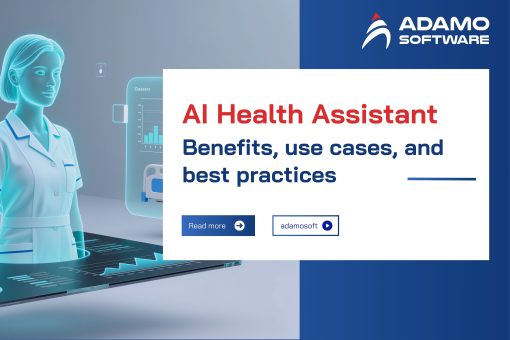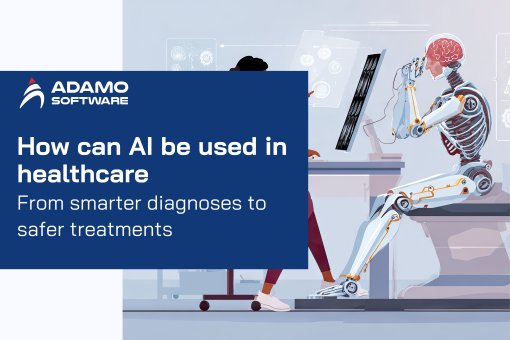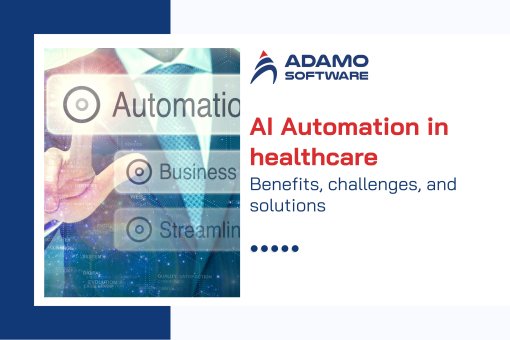Types of mHealth apps: Discover the top features to include

In the digital age, healthcare is becoming more accessible and convenient thanks to mobile health apps. This way, people do not need to go to the hospital to monitor their health status and can do it right at home. You can check your body temperature and heart rate as well as consult a doctor online.
As mHealth apps become more popular, you must understand what is mHealth apps, their core features and how they can benefit patients and healthcare providers.
Based on our extensive expertise in software development for the healthcare industry, we go over important information about creating a mobile healthcare solution in this blog. These include the types of mHealth apps and the essential features for any successful product.
I. Types of mHealth apps: Current statistics
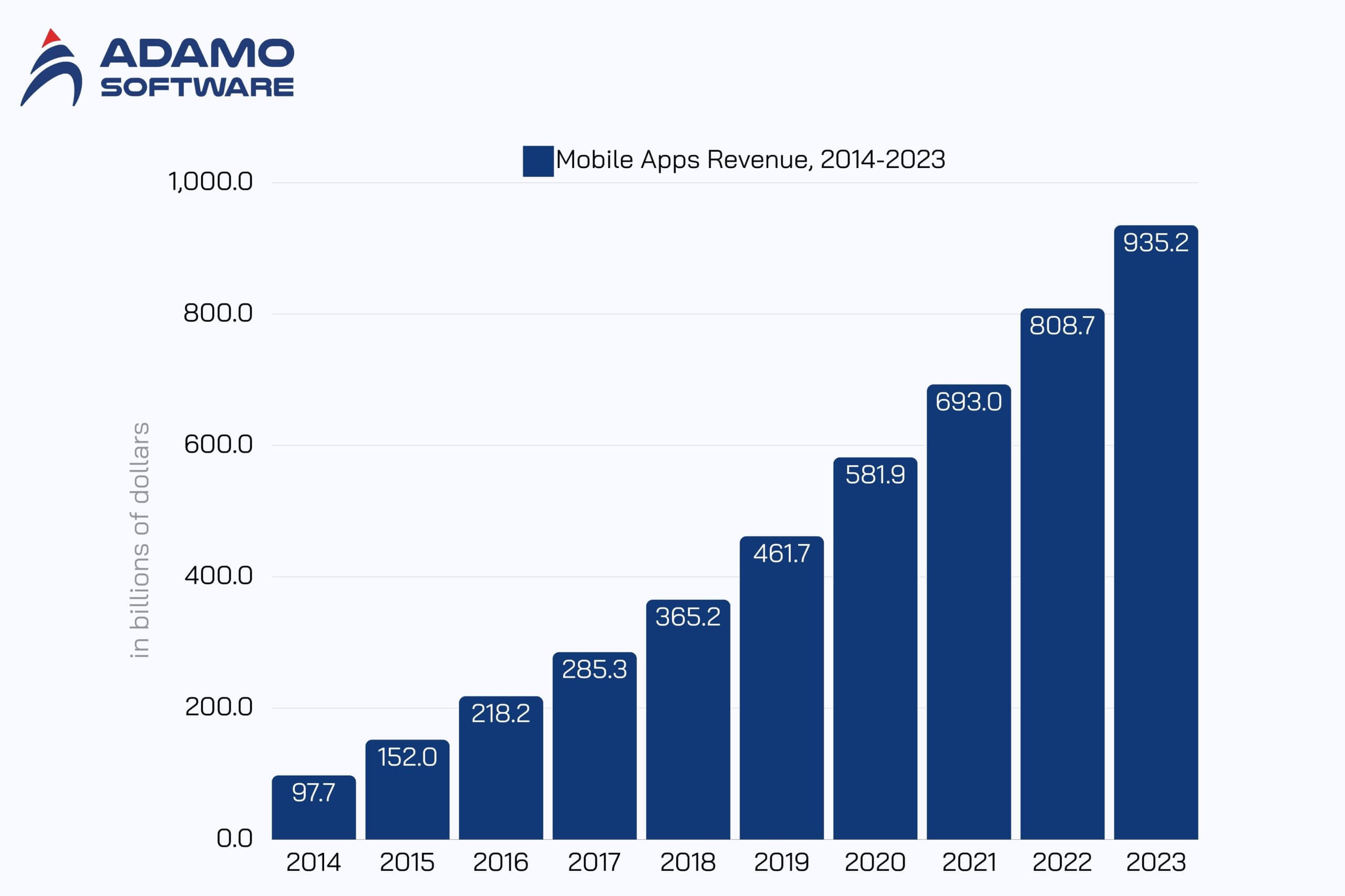
Statista data suggests that the current number of smartphone users worldwide is estimated at 6.92 billion. This shows that the percentage of smartphone owners account for about 86.29% of the world’s smartphone population. This increase shows that smartphones have made it easier for people to access many digital tools and services. Among them, healthcare services are worth mentioning.
The mHealth app market has seen significant growth in recent years. According to a report by ResearchAndMarkets, the global mHealth app market size is expected to reach US$105.9 billion by 2030. Moreover, it is expected to expand at a CAGR of 11.8% during the forecast period.
According to another study, more than 350,000 mHealth apps are available in major app stores. This includes both medical apps as well as health and fitness apps. This number has doubled since 2015. This increase is due to the increasing adoption of smartphones. It is also due to the continued strong investment in the digital health industry.
In addition, the adoption of mHealth apps has been further accelerated by the COVID-19 pandemic. Many use these apps for remote consultations, self-monitoring, and medication management. In addition, mHealth apps are becoming essential tools for patients and healthcare providers. They are used to manage health and wellness, chronic conditions, and support mental health care.
II. Different types of mHealth apps
Within the vast market of mHealth apps, many types of mHealth apps are designed to address specific health and fitness needs.
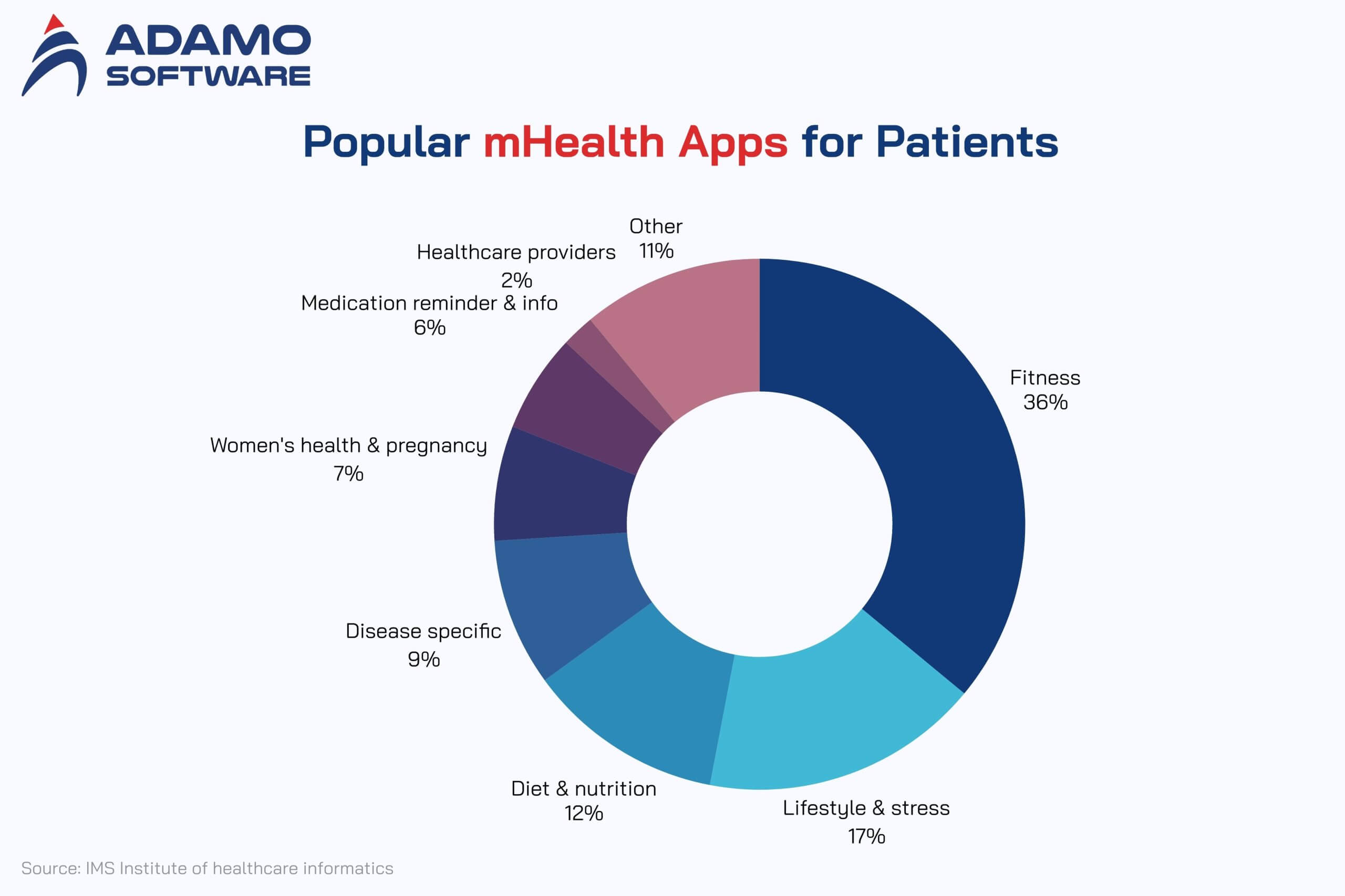
1. Clinical and diagnostic apps
Clinical and diagnostic applications are among the types of mHealth apps. This is considered an essential application in modern healthcare. It allows for data collection, analysis, and sharing among healthcare professionals. Moreover, these applications also streamline the diagnostic process by providing access to test results, health records, and imaging tools. This brings many benefits for both patients and doctors.
The application provides features such as symptom checking and disease diagnosis that help improve the quality of healthcare services. Among the types of mHealth apps, clinical and diagnostic applications play a very important role.
VisualDx is a prime example of this type of mHealth application. It provides an extensive database that helps professionals diagnose medical conditions. Users enter their symptoms and medical history, and it generates potential diagnoses to help them make informed decisions. By leveraging technology, these applications help improve the accuracy of diagnosis and patient care in clinical settings.
2. Remote monitoring apps
Next are remote monitoring applications. These applications are transforming the delivery of healthcare services today, as well as providing virtual care at home. It allows doctors to remotely monitor patients’ vital signs, such as heart rate, oxygen levels, and blood pressure. In this way, patients can improve their health conditions without visiting the hospital regularly. Therefore, integrating remote applications into hospital services is very important.
Among the types of mHealth apps, “Apple Health” is a prominent example. It can track various metrics, from heart rate to sleep patterns. In addition, specialized applications such as “Cardiogram” are used to monitor cardiovascular health and “Sleep Cycle” to monitor sleep and provide appropriate solutions.
Thanks to these applications, users can monitor their health remotely. At the same time, they can share data with healthcare professionals to improve management and care, marking a significant change in healthcare models.
3. Productivity apps
One of the popular types of mHealth apps is the productivity app. It revolutionizes the workflow for providers. Indeed, it is designed to be efficient and streamline scheduling, charting, and dictation in a HIPAA-compliant environment. With the necessary features, these types of mHealth apps are indispensable for providing quality care anytime, anywhere.
One prominent example is “Doximity”. This application is tailored specifically for medical professionals. It offers HIPAA-compliant messaging, medical news updates, CME opportunities, and tools for scheduling appointments and managing patient information.
The app has various features to meet healthcare providers’ diverse needs. Thus, ensuring seamless communication and organization and providing optimal patient care.
4. Reminder apps
Reminder apps are an indispensable mHealth type in the healthcare industry. They ensure patients maintain their appointments and medication schedules without delays or errors. These apps provide tailored reminders, appointment details, and confirmation functionality, even when integrated into larger platforms. Or even stand-alone like RevSpring Patient Connect. Reminder apps prioritize patient adherence. This facilitates seamless communication with healthcare providers. Ultimately, it enhances healthcare management.
Medisafe is a popular mHealth reminder app. It allows doctors to effectively manage medication schedules by sending timely reminders. It also tracks adherence and provides features like drug recognition and interaction checking. The main goal of the reminder app is to increase patient medication adherence and improve health outcomes. Thus, it is an important component in the spectrum of mHealth apps.
5. Text and Video Communication apps
The pandemic has underscored the critical role of mHealth apps. One of the important types of mHealth apps during the social distancing period and today is text and video communication apps. These platforms allow patients to interact with their caregivers seamlessly, improving healthcare access and quality. Not surprisingly, these apps allow for live text or video conferencing consultations. Thus, they help people connect with providers, ensuring timely support and effective treatment.
“Teladoc Health” is a popular text and video communication mHealth app. It offers virtual healthcare services, text messaging support, and specialist video consultations. With this app, patients can access remote medical care and consultations and even experience the benefits of modern healthcare firsthand.
6. Prescription Apps
Prescription apps are essential mHealth applications. They enable the delivery of tailored medications and dosages. This ensures patient safety and compliance. Furthermore, these tools empower physicians to monitor the effectiveness of treatment remotely. Patients benefit from personalized care, minimized side effects, and optimized outcomes.
A prime example of a widely used prescription app is “DrFirst.” Using the DrFirst app, healthcare providers can electronically prescribe medications directly to pharmacies from their mobile devices. It helps streamline processes, increase accuracy, improve safety, and reduce errors in paper-based prescriptions. DrFirst exemplifies the advancements in mHealth technology. It revolutionizes the way prescriptions are managed and enhances patient care.
7. Mental health apps
Finally, mental health apps are one of the important types of mHealth apps. Besides physical health care, mental health also needs special attention. With the help of these apps, the accessibility, flexibility, and effectiveness of therapy are enhanced. They address depression, stress, anxiety, and sleep issues through various features, including pre-recorded meditations, breathing exercises, and gaming elements. They mostly offer a variety of approaches to health.
MHealth apps are all tailored to each mental health condition. At the same time, they empower users to prioritize their mental health on the go.
III. Must-have features of an ideal mHealth app
A complete healthcare mobile application must include important interconnected features to run properly. Each feature plays a very important role in improving the efficiency of the application and engaging users.
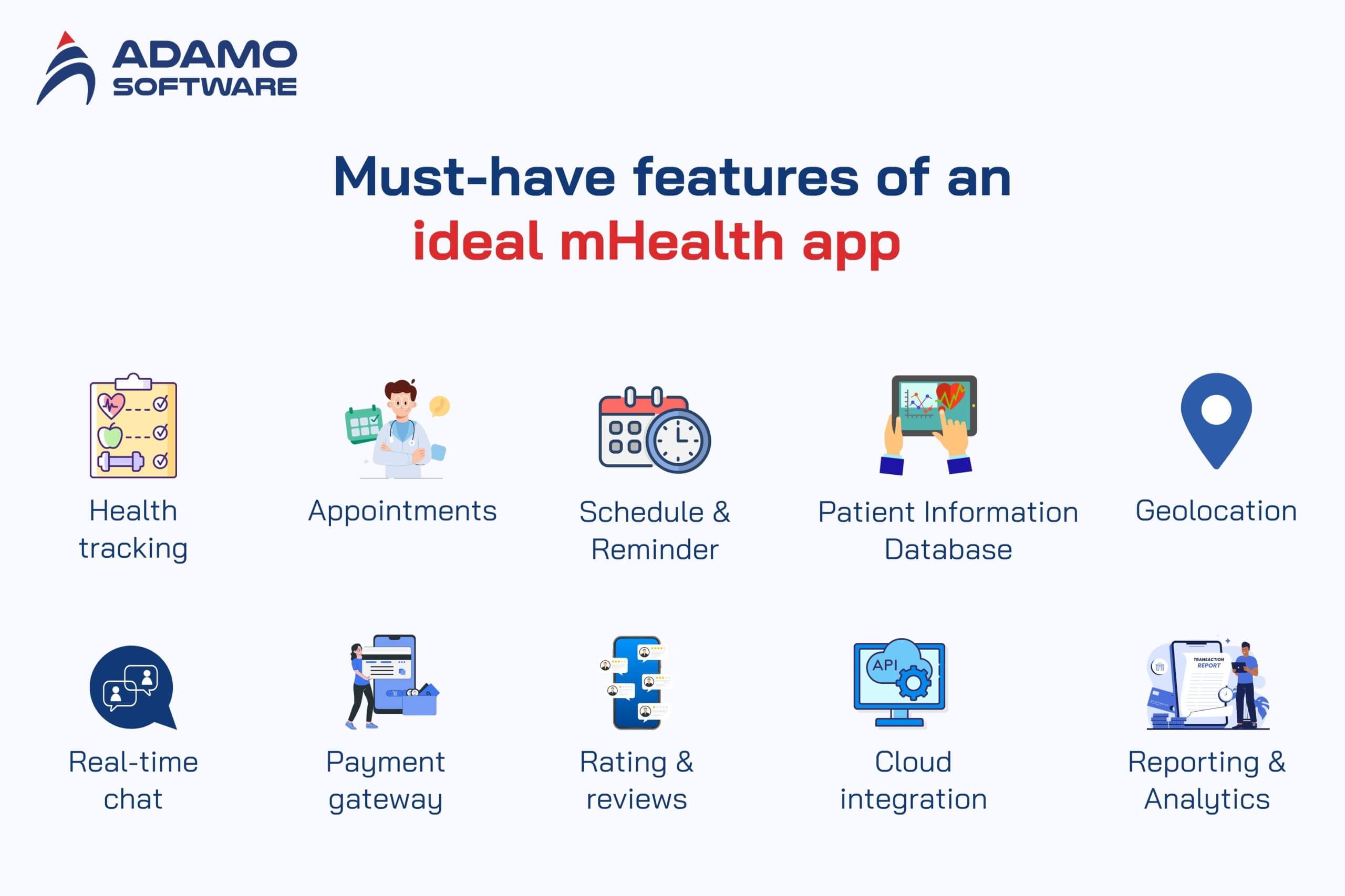
Here are the must-have features in a healthcare mobile application:
1. Health Tracking
First of all, health tracking is the most essential feature of mHealth apps for doctors and patients. This feature helps doctors monitor patients’ vital signs and health status, from monitoring blood pressure, pulse rate, calorie intake, blood sugar, and calorie intake.
2. Appointments
Appointment creation is a must-have feature for any mHealth app for patients. It allows patients to request appointments with their doctors easily and quickly. At the same time, it helps doctors have a comprehensive understanding of the appointments they must attend in a day.
In addition, one of the main benefits of appointment creation is eliminating the chaos of schedules and waiting rooms. For example, some apps like Zocdoc only work around this feature set.
3. Schedule and Reminder
Forgetting to take medication is a common occurrence for patients. Therefore, the schedule and reminder feature is very necessary and mandatory. It helps patients schedule their medication, track their sleep, drink water, or remind them of their daily calorie intake, etc. In addition, this feature also makes it easier for patients to track their health goals.
4. Patient Information Database
Doctors and healthcare organizations primarily use this feature. This feature gives caregivers real-time access to a patient’s medical history, reports, prescriptions, etc.
5. Geolocation
It is also one of the essential features. It is often used in emergency situations. With this feature, patients can use the app’s map integration to find nearby doctors and hospitals.
6. Real-time Chat
It is the newest feature but a must-have for any healthcare app. Due to social distancing in the COVID-19 era, people have needed telemedicine support services. Patients need to connect with their doctors while confined to their homes. This has led to the need for real-time text, voice, and video chat.
7. Payment Gateway
To help your mHealth app stand out, you can integrate mobile payments with the most attractive features like online banking, e-wallets, and debit/credit cards. This allows patients to pay for their insurance and treatment costs conveniently. In addition, integrating a payment gateway also supports bill copying and document access.
8. Ratings and Reviews
Nowadays, many doctors and hospitals operate across every city, making it difficult for patients to evaluate the effectiveness and trust of those who care for their health. To solve this problem, you can also integrate ratings and reviews into the list of features.
9. Cloud Integration
Cloud storage is a must-have feature in all sectors, and healthcare is no exception. You know that hospitals need to store a lot of patient data every day. Therefore, storing patient data in a secure cloud infrastructure is extremely important. Moreover, the necessity of keeping data safe is also a big reason why the healthcare industry is exploring blockchain technology and its decentralization capabilities.
10. Reporting and Analytics
The final feature on the list of must-have mHealth app features is reporting and analytics. Every healthcare mobile app development company focuses on creating dashboards for stakeholders. These dashboards help track health, patient numbers, and finances. They also monitor other critical factors affecting the field and overall health.
IV. Challenges you should consider before investing in mHealth app
Along with the benefits of mHealth apps, you should also consider the disadvantages and challenges before investing in a mHealth app:
1. Data Security and Privacy Concerns
Security and privacy are among the biggest concerns for users of all apps. This is especially true for mHealth apps that deal with sensitive health-related data. Therefore, when developing a mHealth app, you must consider important issues such as authentication, privilege management, secure data storage and transmission, compliance, testing, and installation.
2. Regulatory Compliance
Another challenge is regulatory compliance. mHealth apps must comply with HIPAA, HITECH, FDA medical device regulations, and GDPR, where applicable. This is an important factor in ensuring the safety and security of your app.
3. Ensuring Clinical Accuracy and Credibility
Your mHealth app must offer accurate, evidence-based information to establish trust and demonstrate credibility. Regular updates are necessary to keep the information current and relevant. To validate the content, conduct peer reviews and consult healthcare professionals to ensure its accuracy and reliability.
4. Addressing the Digital Divide and Accessibility
Next, making healthcare services and resources available to everyone is the biggest concern for mHealth apps. However, this can be addressed by offering services in multiple languages and low-cost versions. Additionally, you should partner with local healthcare providers and implement offline modes so that users can access content without an internet connection.
5. Overcoming User Adoption Barriers
Finally, healthcare providers and patients face several barriers when using online applications. These include a need for more technical skills. Faulty integration processes can also cause issues. Additionally, security and privacy concerns are major challenges. Therefore, you should know how to address such matters to ensure all users have a positive experience with the application.
V. Trust Adamo Software for a successful mHealth app

Adamo Software is your trusted partner for building a successful mHealth app. With years of experience creating secure and user-friendly healthcare solutions, we specialize in developing custom apps that meet the unique needs of healthcare providers and patients.
We prioritize compliance with industry standards, including HIPAA, ensuring your app is secure and meets all necessary regulations. Our team works closely with you to design healthcare solutions that streamline clinical workflows and improve patient care. Whether you need a simple tool or a comprehensive platform, Adamo Software has the expertise to bring your vision to life.







